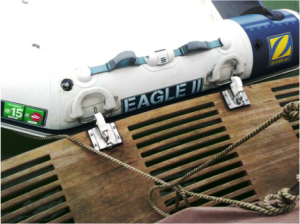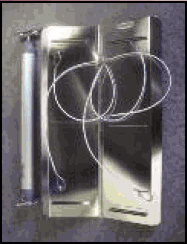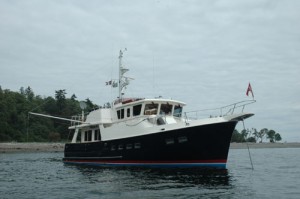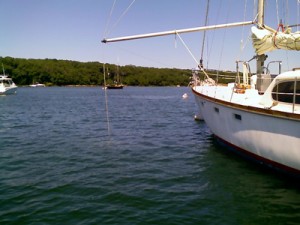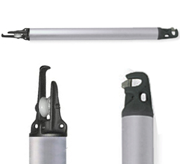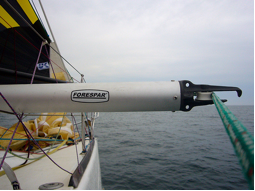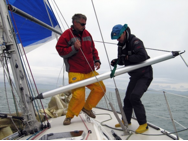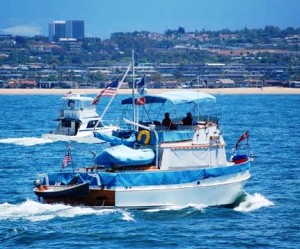Forespar's Point of View
Blogging About Life on the WaterAbout Mike Dwight
View all posts by Mike Dwight
Yes, Go Digital Onboard Too!
Now there are several digital options to keep track of and remind you or your crew of all your yacht-system service needs. This can include a ship’s log, maintenance history, and inventory of all parts and consumables normally kept on board.
Once all the information is gathered by its technicians, one of several vendors can create a customized program that is specific to your boat, not necessarily generic to the boat brand or model. It also has a less-expensive “customer implementation” option, in which the boat owner gathers and provides all the necessary information required. Once the implementation process is complete, all of your boat’s information and records are stored in the cloud and accessible via computer, tablet or smartphone.
Three of the top names in the rapidly evolving product category of yacht-maintenance management are My-Villages, Wheelhouse Technologies and VesselVanguard. Hosted online, these subscription-based systems host data securely on a remote server.
These low costs systems allow you to avoid spending your time flipping through manuals and to get maintenance needs off your mind. Boaters have more important things to think about, like planning that next voyage.
~ Forespar Point of View Team
FAQ of the Week
Q: What length Forespar® whisker pole I should buy?
A: The size of your whisker pole depends entirely on the length of your boat. A small boat requires a shorter pole, while a larger boat requires a longer pole. Diameter is a major function of strength. A 2-1/2” diameter tube is as much as 70% stronger than a 2” diameter tube. The force created by the headsail can cause a pole to bend or break if it is not the right size.
Every Forespar® pole is custom designed for each type of boat based on the J dimensions, the length from the headsail pin to the front of the mast. Labels on the whisker poles note the maximum length boat that can be used for each pole.
We strongly suggest you use our size recommendations when selecting the pole for your boat. Forespar® cannot offer any warranty on poles that are too small for the boat. Here’s a link giving you recommended poles for each brand of boat. http://www.Forespar.com/whisker2011.shtml
If you have any further questions or need replacement parts, please contact us at sales@forespar.com.
Let’s Keep It Clean
The goal of the boater-funded BoatUS Foundation for Boating Safety and Clean Water is to educate boaters about safe and clean boating. The Foundation wants to fund Grassroots Grant projects that utilize new, innovative approaches that encourage safe and clean boating among the boating public.
Organizations with the best ideas will be awarded grants of up to $10,000 to implement their project. However, applications need to be submitted by January 15, 2015, and public online voting on the applications will take place in early spring 2015.
Groups wishing to apply for one or more Grassroots Grants may go to www.BoatUS.org/grants to view the guidelines and begin their application. Grant application submissions may include videos, photos or graphics or anything to potentially help increase the chances of funding. The applications that best meet guidelines will be posted to the Foundation’s website, BoatUS.org, as well as its Facebook page for public voting in the spring. Projects with the most votes will receive funding and will have one year to complete the grant project.
~ Forespar Point of View Team
Coast Guard Drops Type Code Labels for Life Jackets
The Coast Guard is dropping its Type I-V labeling system. This move is expected to lead to new life jacket designs and lessen confusion among recreational boaters. The plan is to drop the current life jacket type code scheme that has been used for years to label and differentiate the types of life jackets and their specific use.
These new standards will eventually simplify life jacket requirements for recreational boaters. The decision eliminates the Type I, II, III, IV or V label on a new life jacket label after Oct. 22. This coding tended to confuse boaters, limited choice and increase the cost of life jackets.
Boaters must still abide by the current standards when using older life jackets marked with the Type I-V labeling because they will remain legal for use.
More details are available at BoatUS.org/design.
~ Forespar Point of View Team
Boat Show Season Is Here…How To Pick Your Boat!
For boaters who have the courage to go “boat hunting” or just to “take a look” you will likely wind up wanting to buy at least three that you find.
Making the right decision about your selection process can be simplified if you use these seven hints during the journey:
- You start comparing all other boats to her. It’s okay to admire the also-rans, but usually that just proves which boat owns your whole heart.
- You gasp. Out loud. With the one, this will happen repeatedly, to the point that strangers may ask if you’re having an asthma attack.
- You can’t stop touching her. If you hear yourself saying something like, “The texture of these teak handrails is just absolute perfection,” it’s a sign that you’re going over the edge.
- Her smell lingers on your mind. Whether it’s the chlorine from the hot tub or the diesel from the engine room, somehow it all smells like a sweet French fragrance to you.
- The helm seat fits you perfectly. Every gauge is at eye level, every control is within easy reach, every inch of your rear-end is cushioned and every dollar you have will soon belong to the builder.
- You stand, fully clothed, in the master cabin shower. We all know you’re dreaming about adding a steam feature and the spaciousness. You can’t hide it at this point.
- Your better half gives you the nod. If your spouse says yes, make the deposit without delay. You’ll never get another chance this good to spend money on the mistress of your dreams.
* Points provided by Yachting Magazine
~ Forespar Point of View Team
Sailing Downwind with Double Headsails
It sounds a lot more complicated than it is. All you need is:
- your usual genoa
- a second headsail
- a mast with two foresail halyards
- a whisker pole
Your course is deep off the wind. The breeze is light to moderate, and you’d like to be moving faster, but either don’t have a spinnaker aboard, or just don’t want to wrestle with it. Wing-and-wing isn’t working because your course isn’t dead down wind, or you just don’t want to deal with the constant trimming.
The usual solution is to come up on the wind, heat it up and get some boat speed, gybing your way to your mark. It’s more work, but it can get you there faster if you plan your gybes well.
Or go with two headsails.
Get the other sail on deck (it doesn’t matter if it’s your jib, another genoa, or in light air an appropriate sail). You can set a sheet for the windward side, or even detach the lazy sheet from the working sail, as long as you remember to re-attach it before any gybes. Get the free halyard and new sheet hooked up with plenty of slack, and the new sail tacked on. Make sure the pole is ready to go. (We use a Forespar twist-lock pole, which adjusts to the right length for whatever sail we’re using).
Hoist the new windward sail, attach the pole as close to the sail clew as you can, adjust the pole length, and trim on. The rest is adjustment for the course and breeze. Then watch the boat go faster, especially in light air.
You can go faster and deeper, with less work. Some races even allow double headsails (we’ve had great success in “inside” races using a light 155 genoa and our drifter).
Try it on light days when you’ve got room to work, adjust and trim. It’s easy to do with two people, requires a lot less muscle.
Go sailing. Have fun.
Mike Dwight
What Good is a Dinghy Davit on My Swimstep?
The obvious benefit is the ability to hoist your inflatable dinghy up on the swimstep while it’s inflated. That way, you’re not fighting to unroll, inflate and float the dinghy using the limited deck space on a small to medium sized boat, and then reverse the process. Often, that means you’re spending as much time setting up the supposedly convenient dinghy as you did on the voyage.
Plan B is to tow the dinghy. For a longer trip, especially at sea, this can be an adventure of its own. Speed, tow distance from the boat, cleats (often not designed for those loads) and tow lines and yokes can be a real pain. We haven’t even mentioned the motor, gas can and cargo.
With the swimstep davit system, you can simply bring the dinghy alongside, clip it on and tilt/hoist it in. A side and actually major benefit is overnight stays. By clipping the dinghy into the Davit, we can be sure that it sits quiet in the water. There’s no banging on the hull, drifting into the fairway, worrying about the painter, etc. Easy passenger boarding from the swimstep, and easy back onto the boat.
We’re using the Forespar QuikDavit ™version on two boats. One on the Grand Banks, used for hoisting and parking the smaller dinghy, and with the mounting pads the same distance apart for docking the bigger Caribe.
The Wellcraft uses the full QuikDavit kit as designed. It is easy for Pat (the real Skipper) to use, and was easy to install on both the wood step and the thicker step on the smaller boat. It makes for a much more pleasant cruise, and has proven to be well worth the money.
Rock and Roll
There’s a place for rock and roll and it’s not on an anchored boat.
Salt water boaters often find themselves anchored or on a mooring. There’s a swell, a surge from the swell or just enough breeze to create some waves, all just enough to rock the boat. That rock can be strong enough to be uncomfortable. It is hard to sleep with a grip on the mattress, and an evening on the deck or in the cockpit isn’t very comfortable.
A flopper stopper is the solution. I’ve tried several types over the years, and settled on one that works across the board – the Roll-X™ from Forespar. The same system has dampened the roll quite well on my power boats (a Grand Banks 42 and a 28’ Wellcraft) and my sail boats (a Baltic 52, and a Soverel 33), as well as other vessels.
The Roll-X stabilizer consists of two stainless plates, about 12.5 by 40 inches, hinged together, and supported by a single line attached to a basic harness. It works simply. On the down roll, the unit folds together on the hinges, and drops deeper. On the up roll it unfolds, creating about seven square feet of resistance – sufficient to dampen a dramatic roll, completely quash a smaller wake or wind wave. And, the Roll-X has winglets to minimize the “skate” fore and aft while down, making the ride even more.
Roll-X stabilizer is most efficient when used with a pole to increase the leverage (one comes with the kit). You can see how on the trawler below.
Many sailors use the poles they’ve already got – spinnaker pole, a heavy whisker pole and often the boom. Swing it out on a halyard or topping lift, and couple of lines for guys and the crew is going enjoy a lot more stable time at anchor.
Candidly, the Roll-X stabilizer works pretty well as a flopper stopper with no poles, although using two (one on each side) helps make up for the lack of leverage. They are simply lowered over the side, down six or eight feet, and made fast to the cleats nearest the beam of the boat. Yes, we were in a hurry, or just too lazy to rig properly. They do work better poled out, and you must be sure to hoist the stabilizers in before weighing anchor and sailing away.
You can be sure that you’ll be well rested because you’ve experienced a lot less rock and roll.
Mike Dwight
What is a Spinnaker Strut?
And Why Do You Need One?
A Spinnaker strut is a relatively short (usually aluminum) pole with one end fitting designed for mast attachment, and the other for running a line across a small internal pulley. Standard sizes range up to about seven feet in length and three or four inches in diameter. They look like this:
As its name implies, the strut is for use with a traditional symmetrical spinnaker. It will keep the afterguy (or the spin sheet you’re using as an afterguy) attached to the spinnaker pole away from lifelines, stanchions and other undesirable points on its way back to the stern.
The strut is usually attached to the mast via a padeye on the mast, and often held in position with a sail tie to a shroud
Sailors want a reaching strut because:
- With the afterguy riding across the sheave in the end of the strut, the pole is much easier to control and adjust. Eliminating the friction is important.
- The line will chafe as it rides across the lifeline, stanchions, etc. Decent line for sheets and guys starts at about 75 cents a running foot, and the good stuff at twice that. Unnecessarily replacing it gets old in a hurry.
- The load on the afterguy can be significant if it’s blowing. That can and will bend the lifeline and stanchions.
- Crew on the rail will be safer and happier without a loaded (and possibly weak) guy on their chests or backs.
And, more important – when sailing fairly close to the wind with the spinnaker, the pole is well forward. In a good breeze the afterguy or sheet is loaded. If that lifeline or stanchion (or both) bends enough, or breaks, the pole will slam forward into the forestay. Bad things can happen. Very bad things.
A reaching strut is easy to rig, and easy to use. Because it’s fairly short, it’s also easy to stow. And not expensive , especially when you consider the cost of a forestay or mast.
Waterways – Travel Responsibly
We‘ve all seen, and probably done, not-so-bright things when traveling from Point A to Point B in a boat.
A couple of years ago, we were idling along a mile offshore, headed for Catalina, getting fishing rigs ready and testing systems. Visibility was down to under 200 yards, we were about a half-mile to the west of the “freeway”. We hear an engine roaring, and a close blip appears on the radar. We ring the bell just in case.
Sure enough, a family in 20+ foot bow-rider boat appears, with the driver waving. We stop, he comes along side. Pointing into the fog, he yells, “Which way to Catalina?” He’s already lost.
It’s a fairly big island, with the long axis parallel to the cost making it easy to see on a clear day. The island is 26 miles away, so there’s a lot of water, almost always a swell, and a major shipping channel to cross. It can get fairly ugly in the middle of the channel, and sea and the current generally will set you off a few degrees to your left (East). If you are headed for Avalon – the town and primary harbor – with inadequate navigation, it’s not that hard to miss the island entirely.
This boater was headed to sea, with no GPS, no chart, and a compass and a radio he didn’t know how to use. I strongly suggested that he go back and not further endanger his family, and offered to lead them to the harbor entrance. His wife insisted strongly that he comply – you can imagine that conversation – and we led them back to the harbor.
The point here is responsibility. Having the keys to boat and taking the helm makes you responsible for all souls on board, whether it’s on the ocean, the river or the lake.
Know where you’re going and how to get there. Have and know how to use basic navigation and safety equipment. Have a grasp of the hazards – wet, dry or breathing – that you may encounter. Save the beer for later. Before you turn the key or hoist the sail, remember that the welfare of you family, crew and passengers is in your hands.
You’re responsible.
~ Mike Dwight
